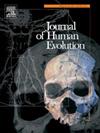南方古猿阿法种继续树栖的锁骨证据
IF 3.1
1区 地球科学
Q1 ANTHROPOLOGY
引用次数: 0
摘要
古人类谱系的出现标志着向两足动物的过渡,但关于这种转变期间和之后树栖行为的作用的争论仍然存在。围绕南方古猿运动习惯的不确定性部分源于其骨骼的马赛克性质,骨盆和下肢特征主要表明两足行走,而上肢形态保留了与现存猿的树栖生活有关的原始特征。对骨骼内部结构的分析加上新的化石证据可能会在这方面提供新的见解。在这里,我们首先描述了幼年南方古猿阿法种个体DIK-1-1的锁骨,然后与成年Au一起进一步研究了锁骨的形态。以KSD-VP-1/1为代表的阿法种,利用几何形态计量学和皮质横截面几何来识别和解释潜在的功能信号。我们的发现挑战了现代人锁骨形态不同于黑猩猩的观点,揭示了人类和潘人在锁骨外部形状上的显著重叠。相反,在现存类人猿和金猴中,内部皮质几何结构都表现出发育可塑性。阿法种,支持其在探索运动适应性方面的效用。此外,Au和Au之间的内部皮质几何结构相似。阿法古猿和现代猿类支持一种假说,即阿法古猿在其一生中都有持续的树栖行为——包括悬浮和攀爬。外部形态和内部形态之间的不一致突出了在以前被归类为“原始”的古人类锁骨中识别未识别功能信号的潜力,并提醒人们不要仅仅基于外部形状进行过于简化的分类分配。最后,这些结果强调了从形态学的全面视角来更好地理解早期人类运动进化的重要性,并强调了在Au中持续的树栖性的相关性。脚骨。本文章由计算机程序翻译,如有差异,请以英文原文为准。
Clavicular evidence for continued arboreality in Australopithecus afarensis
The emergence of the hominin lineage is marked by the transition to bipedalism, but debates persist regarding the role of arboreal behaviors during and after this shift. Uncertainties surrounding the locomotor habits of Australopithecus partly stem from the mosaic nature of their skeleton, with pelvic and lower limb traits principally indicating bipedalism, while upper limb morphology retains primitive features largely associated with arboreality in extant apes. Analyses of internal bone structure coupled with new fossil evidence may provide new insights in this regard. Here, we first describe the clavicles of the juvenile Australopithecus afarensis individual DIK-1-1, then the morphology is further investigated alongside adult Au. afarensis, as represented by KSD-VP-1/1, using geometric morphometrics and cortical cross-sectional geometry to identify and interpret potential functional signals. Our findings challenge the notion of a distinct modern human clavicular morphology as separate from chimpanzees, revealing significant overlap in external shape between Homo and Pan. Conversely, internal cortical geometry exhibits developmental plasticity in both extant apes and Au. afarensis, supporting its utility in exploring locomotor adaptations. Furthermore, similarities in internal cortical geometry between Au. afarensis and modern apes support hypotheses of continued arboreal behavior—including suspension and climbing—throughout life in the former. The discordance between external and internal morphology highlights the potential to identify unrecognized functional signals in hominin clavicles previously categorized as ‘primitive’ and cautions against oversimplified taxonomic assignments based solely on external shape. Ultimately, these results emphasize the importance of taking a comprehensive view of morphology to better understand locomotor evolution in early hominins and underscore the relevance of continued arboreality in Au. afarensis.
求助全文
通过发布文献求助,成功后即可免费获取论文全文。
去求助
来源期刊

Journal of Human Evolution
生物-进化生物学
CiteScore
6.30
自引率
15.60%
发文量
104
审稿时长
3 months
期刊介绍:
The Journal of Human Evolution concentrates on publishing the highest quality papers covering all aspects of human evolution. The central focus is aimed jointly at paleoanthropological work, covering human and primate fossils, and at comparative studies of living species, including both morphological and molecular evidence. These include descriptions of new discoveries, interpretative analyses of new and previously described material, and assessments of the phylogeny and paleobiology of primate species. Submissions should address issues and questions of broad interest in paleoanthropology.
 求助内容:
求助内容: 应助结果提醒方式:
应助结果提醒方式:


